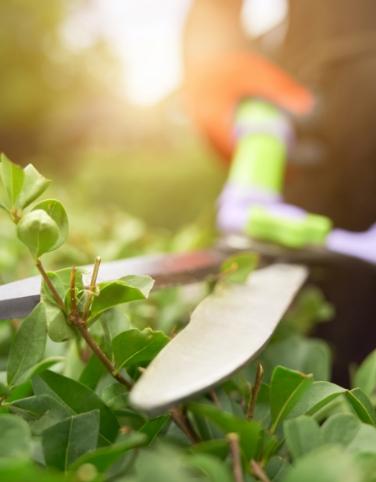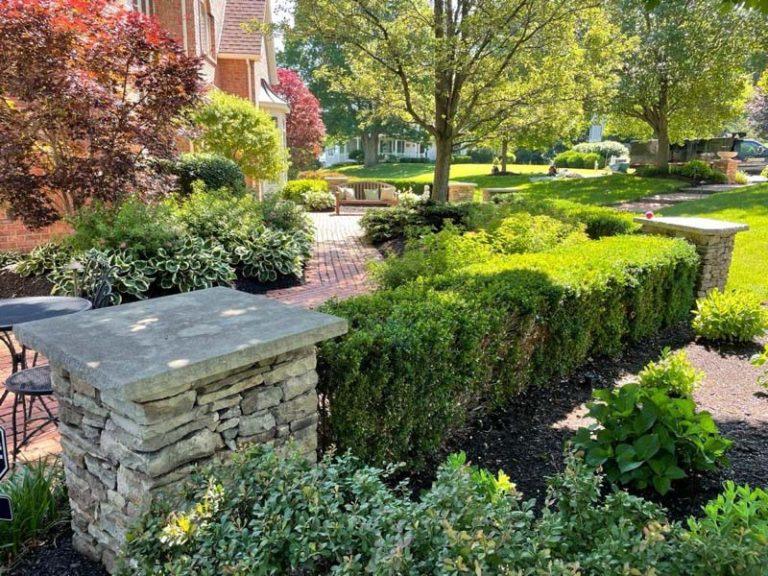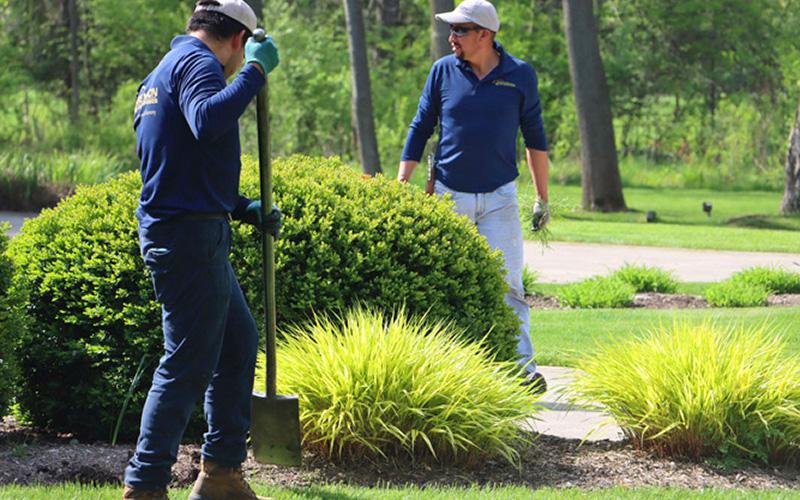Landscape Installation After Care
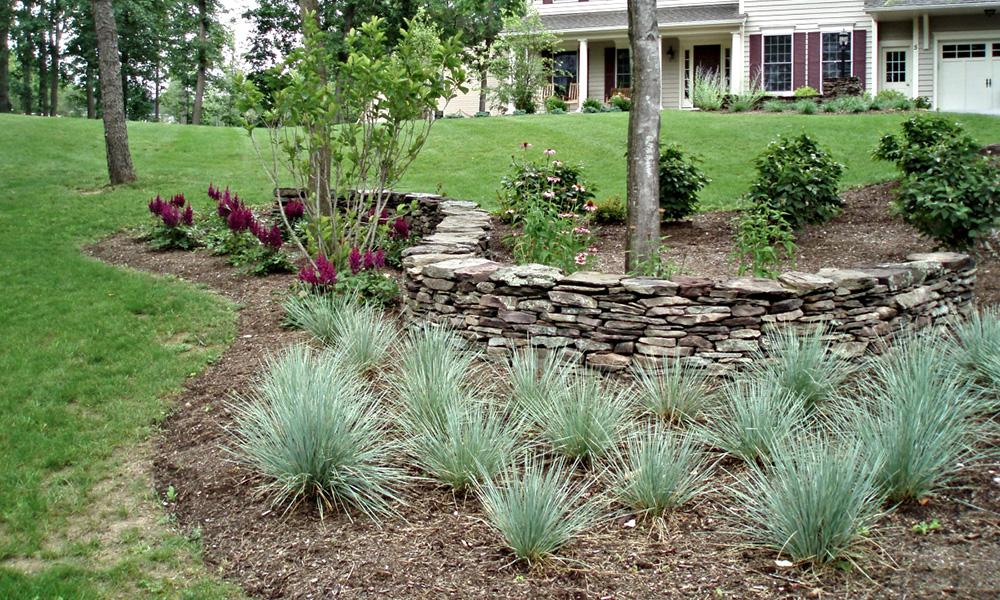

How Do I Care For Trees And Shrubs After Planting?
We have compiled some information to help with the care of your new landscape. Upon completion of your project, we will walk through your property with you to explain and show you the proper care of your new plantings and hardscape. Benson Enterprises also provides a full range of maintenance services to help keep your property looking lush and healthy. Please feel free to contact us with any questions or concerns you might have; we are here to serve you. Enjoy your new landscape and thank you again for you valued business.
Watering
After your landscape has been completed, some of the most important care begins with proper and regular watering. Proper watering techniques often make the difference between a plant that thrives or one that just survives.
Shrub and Tree Watering Techniques
When watering small to medium shrubs and small trees, each planting requires 20-30 seconds of watering with the spigot on half speed. Try to avoid a lot of contact with the foliage as this will only take water away from the roots. Also try to avoid water run off. For large trees and shrubs, the best way to water is set the hose down next to the trunk with the spigot on ¼ speed and let the water soak into the ground for about 5-15 minutes (based the size of the planting and your soil type). If you tend to get run off when watering, simply turn down the spigot.
Recommended Watering Schedule
The frequency and amount of water that your plants will need depends on the weather and soil type. Days that see a ½” of rain can be skipped and regular watering can resume on the next scheduled day. Follow this schedule for the first two months or through the hot and dry season. Be careful to avoid over watering, too much water is worse than too little water. If you are unsure on the proper watering of your new plants please give us a call.
Temperature | Soil Conditions | Watering |
50°-60° | sandy soil | 1x per week |
50°-60° | clay soil | 1x per week |
50°-60° | loam soil | 1x per week |
60°-70° | sandy soil | 1-2x’s per week |
60°-70° | clay soil | 1x per week |
60°-70° | loam soil | 1-2x’s per week |
70°-80° | sandy soil | 2-3x’s per week |
70°-80° | clay soil | 2-3x’s per week |
70°-80° | loam soil | 2-3x’s per week |
80°-90° | sandy soil | 5-6x’s per week |
80°-90° | clay soil | 2-3x’s per week |
80°-90° | loam soil | 4-5x’s per week |
Fertilization
During the planting process your new plants were fertilized with all the necessary nutrients and soil amendments they will need for the first year. After the first year, your new plantings would benefit from occasional fertilizing to help them establish faster and maintain their health and vigor. At Benson Enterprises we use organic fertilizers. The best time to fertilize your new plants is in the Spring or the Fall. If you would like information on deep root fertilizing or other insect and disease preventive programs we provide, please feel free to contact us.
Shrub & Tree Fertilization
When it’s time to fertilize your plants, pull back the mulch to the drip line of the plant . Follow the instructions on the bag and apply the fertilizer around the root ball. Gently mix the fertilizer into the soil with your hands and reapply the mulch. The type of fertilizer depends on the type of plant.
Arborvitae | Acidic |
Azalea | Acidic |
Barberry | Acidic |
Boxwood | Acidic |
Dogwood | Acidic |
Holly | Acidic |
Hydrangea | Acidic |
Juniper | Acidic |
Lilac | Non-Acidic |
Rhododendron | Acidic |
Rose of Sharon | Non-Acidic |
Spirea | Non-Acidic |
Yew | Acidic |
At Benson Enterprises we use the brand Holly Tone for acidic loving plants and Plant Tone for non-acid loving plants. These can be purchased from many home and garden stores.
Pruning
Most landscape plants need regular pruning, whether to preserve a loose, natural form or to create a tight compact shape. A common mistake that people make is to let their plantings go without pruning for an extended amount of time, assuming the plantings are too new to need pruning. After a year has gone by, it’s important to start training your plants by pruning or shearing them. Various “styles” of pruning are employed according to plant requirements and intended use. Fruit trees are pruned for production, hedges for screening and specimens for display. Use well-built, sharp tools. Clean cuts heal, ragged or pinched cuts allow diseases and rot to enter the plant. The mature form should be visualized and each pruning session should be devoted to encouraging that form. Expert pruning requires a broad understanding of growth characteristics, cutting technique, site properties and other factors. Several important techniques must be mastered before actual pruning work begins. We suggest reading a good pruning manual and/or obtaining lessons from an experienced pruner. Pruning is a fascinating art and science and is well worth the effort devoted to learning. If you prefer to have your pruning handled professionally, our trained and experienced Horticulturists can provide this service for you.
What's The Best Way To Care For My New Lawn?


Watering
Watering your new lawn with a sprinkler when the seed is germinating and during the hot and dry times will ensure a healthy lawn. Your newly seeded lawn will need to be watered 1-2x’s during the day to ensure quick germination and then 3-4x’s per week for one to two weeks after your new seed begins to sprout. Then follow a regular watering schedule during the growing season based on the weather and the needs of your lawn.
During the germination of your new seed, you want to water only enough to soak the area and avoid over-watering which may wash the seed away. After the lawn has established itself, water 1/8”-1/4” per time and move your sprinkler around to cover all areas. Be sure to get total coverage and not to leave small patches of dry area.
Mowing
You can start cutting your new lawn when it reaches about 3.5” in length. Be careful for the first few mowings as your new lawn is tender and the ground may be soft in areas (watch your turns).
When mowing lawns, return the clippings to the lawn in order to fully utilize the nutrients and moisture contained in the clippings. Clippings add to the organic matter of the soil and encourage good microbial populations.
When mowing lawns, set the mower to 3 inches mowing height. This mowing height promotes healthier lawns by keeping the lawn cooler, reducing soil temperatures, and reducing evaporation. In addition, the increased shade and lower temperatures will reduce unwanted crabgrass and reduce heat-loving insects such as chinch bugs. Raising the mowing height from 2 inches to 3 inches may not seem like much but it increases the amount of shade on the soil surface by 50%.
How Should I Care For My Patio?
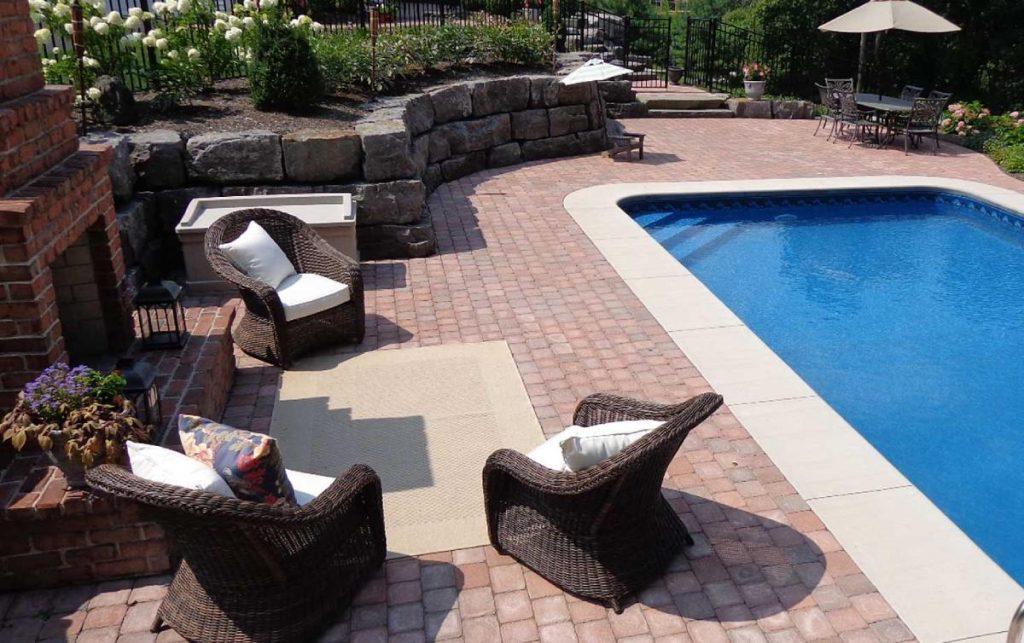

Maintain the Look and Feel of your Patio
Although your new patio is relatively maintenance-free, it may need occasional care. Avoid blowing grass clippings on your paver surface and try to keep it clear of debris that might sprout weed or grass. If you do have anything that grows between the spaces of the pavers, it can easily be solved by occasionally applying a spot weed control like Round Up.
Brick Maintenance
Your patio was installed with the highest of standards and built to last, but as time goes on a brick or two may settle. This is easily fixed by removing the sunken brick and adding a handful of sand. After the sand has been smoothed out with your hand, simply reinstall the brick. It might be necessary to seat the brick with a rubber mallett. If a rubber mallett is not available, use a scrap piece of wood and a carpenter’s hammer.
Enhancing your Patio
Apply a sealer to bring out its color and beauty. There are satin and glossy sheens available and we would be happy to show you samples. Sealing gives a similar look to a wet surface after it rains. We can provide this service to you once your walk or patio has been installed and has had time to weather for about six months or any time after that.
Thank you for giving us the opportunity to provide you with your landscaping services. To help you maintain your new landscaping, we have provided some recommendations for care and maintenance to keep everything looking its best. If you are interested in having Benson Enterprises take care of your new landscaping, we offer maintenance programs that can be tailored to fit your needs. If you have any questions on the care of your landscaping, or are interested in information about a maintenance program or any of the other services we offer, please feel free to call our office at (585) 248-0452 or go to our contact page.
Call Today For A Free Estimate (585) 248-0452
Latest Posts


7 Outdoor Design Ideas for the Winter Season
7 Outdoor Design Ideas for the Winter Season When winter arrives, it’s easy to assume
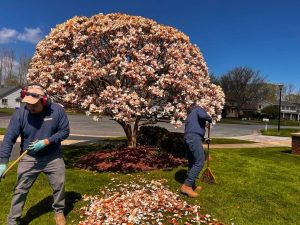

Preparing for Spring with Fall Lawn Care
Preparing for Spring with Fall Lawn Care When summer fades away and cooler temperatures take


Autumn: The Best Time to Plant Trees
Autumn: The Best Time to Plant Trees As the air becomes cooler and the leaves


5 Landscape Lighting Ideas to Brighten Your Backyard
5 Landscape Lighting Ideas to Brighten Your Backyard When it comes to your backyard, it
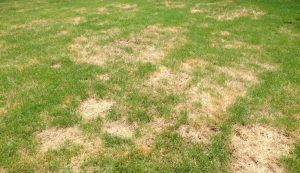

The Risks of a Heat Stressed Lawn and How to Treat It
The Risks of a Heat Stressed Lawn and How to Treat It With the summer

